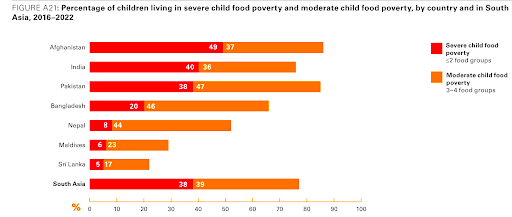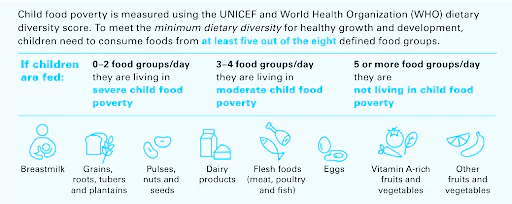Recently, UNICEF released “Child Nutrition Report 2024”– titled as “Child Food Poverty: Nutrition deprivation in early childhood”.

Child Nutrition Report
- The report examines the status, trends, inequities and drivers of child food poverty in early childhood.
- The report also outlines an agenda for tackling the problem, including actions to transform food systems, leverage health systems, and activate social protection systems in ways that put children’s right to food and nutrition in early childhood at the centre.
Enroll now for UPSC Online Course
Key Findings of the Child Nutrition Report 2024
- High Food Poverty: Globally, one in four children are living in severe child food poverty in early childhood, amounting to 181 million children under 5 years of age.
 Over two-thirds of the 181 million young children living in severe food poverty live in South Asia and sub-Saharan Africa, with 20 countries accounting for 65% of the children living in severe food poverty.
Over two-thirds of the 181 million young children living in severe food poverty live in South Asia and sub-Saharan Africa, with 20 countries accounting for 65% of the children living in severe food poverty.- These countries are Afghanistan, Bangladesh, China, Côte d’Ivoire, the Democratic Republic of the Congo, Egypt, Ethiopia, Ghana, India, Indonesia, Myanmar, Niger, Nigeria, Pakistan, the Philippines, Somalia, South Africa, Uganda, the United Republic of Tanzania, and Yemen.
- Non-Uniform Progress: Progress towards ending severe child food poverty is slow, but some regions and countries are proving that progress is possible and is happening.
- Major Drivers of Severe Child Food Poverty:
- Poor food environments for children
- Poor feeding practices in early childhood
- Household income poverty affecting children and their families
- The food, health and social protection systems are failing children’s right to good food and nutrition.
- Conflicts & Shocks: The global food and nutrition crisis and localized conflicts and climatic shocks are intensifying severe child food poverty, especially in fragile countries.
- Concerns:
- Deteriorating Diet Quality: Children living in severe child food poverty are missing out on many nutrient-rich foods, while unhealthy foods are becoming entrenched in the diets of these children.
- Connection to Undernutrition: Severe child food poverty is driving child undernutrition: the prevalence of severe child food poverty is three times higher in countries with a high prevalence of child stunting.
Check Out UPSC NCERT Textbooks From PW Store
About Child Food Poverty
- UNICEF has introduced the concept of child food poverty to bring dietary deprivation and poor quality diets in early childhood to the forefront of global efforts to achieve the nutrition targets of the Sustainable Development Goals.
- UNICEF defines child food poverty as children’s inability to access and consume a nutritious and diverse diet in early childhood (i.e., the first five years of life).

|
Recommendations by UNICEF to End Severe Child Poverty
UNICEF calls on national governments, development and humanitarian partners, donors, civil society and media, academic and research organizations to:
- Elevate Child Food Poverty Reduction:
- To achieve global and national nutrition and development goals and a metric of success in meeting children’s right to food and nutrition.
- To commit resources to end child food poverty.
- Strengthen Data Systems:
- To assess the prevalence and severity of child food poverty.
- To detect increases in child food poverty early, including in fragile and humanitarian contexts.
- To track national and global progress in reducing severe child food poverty.
- Transform Food Systems: To ensure food environments make nutritious, diverse and healthy foods the most accessible, affordable and desirable option for feeding young children, and the food and beverage industry complies with policies to protect against unhealthy items.
- Leverage Health Systems: To deliver essential nutrition services, including counselling and support on child feeding, to prevent and treat child malnutrition, prioritizing the most vulnerable children.
- Activate Social Protection Systems: To address income poverty in ways that are responsive to the food and nutrition needs of the most vulnerable children and their families, including social transfers to protect children at highest risk of child food poverty.
Enroll now for UPSC Online Classes
Various Initiatives taken by India
- Direct Targeted Interventions: Government implements several schemes and programs like Anganwadi Services, Scheme for Adolescent Girls and Pradhan Mantri Matru Vandana Yojana under the Umbrella Integrated Child Development Services Scheme (ICDS) as direct targeted interventions.
- National Nutrition Mission (POSHAN ABHIYAAN): To prevent and reduce prevalence of stunting, underweight and anemia among children (0-6 years) and reduction in prevalence of low birth weight in the country by involving panchayati raj institutions/village organizations.
- Anaemia Mukt Bharat (AMB) Strategy: It was launched in 2018 with the objective of reducing anaemia prevalence among children, adolescents and women in the reproductive age group.
- Poshan Vatikas: To support development of Poshan Vatikas at Anganwadi centres to meet dietary diversity gap leveraging traditional knowledge in nutritional practices has also been taken up.
- Food Fortification: Encouraging the fortification of staple foods with essential nutrients.
- Example: In Karnataka, the government mandated the fortification of edible oils, wheat flour, and salt to improve the nutritional status of the population.
- Public-Private Partnerships (PPPs): For example, the Akshaya Patra Foundation partners with the government in various states to provide nutritious mid-day meals to schoolchildren, addressing both hunger and malnutrition.
|
![]() 10 Jun 2024
10 Jun 2024

 Over two-thirds of the 181 million young children living in severe food poverty live in South Asia and sub-Saharan Africa, with 20 countries accounting for 65% of the children living in severe food poverty.
Over two-thirds of the 181 million young children living in severe food poverty live in South Asia and sub-Saharan Africa, with 20 countries accounting for 65% of the children living in severe food poverty.
